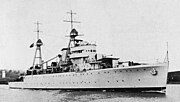| 1936 Portuguese naval revolt | |||||||
|---|---|---|---|---|---|---|---|
| File:1936 Naval Revolt Soldiers Portugal.jpg Mutineers are arrested by government police forces. | |||||||
| |||||||
| Belligerents | |||||||
|
|
| ||||||
| Commanders and leaders | |||||||
|
|
| ||||||
| Strength | |||||||
|
Shore defences 1 submarine |
1 aviso 1 destroyer | ||||||
| Casualties and losses | |||||||
| Unknown |
1 aviso beached 1 destroyer beached 12 sailors killed 20 sailors wounded 238 sailors arrested | ||||||
The 1936 naval revolt (Portuguese language: Revolta dos Marinheiros de 1936 ) or Mutiny on the Tagus ships (Motim dos Barcos do Tejo) was a mutiny in Portugal that occurred on 8 September 1936 aboard the aviso Afonso de Albuquerque and destroyer Dão. It was organized by the Revolutionary Organization of the Fleet (Organização Revolucionária da Armada, ORA), a left-wing group with links to the Portuguese Communist Party. The mutineers intended to demand António de Oliveira Salazar's resignation and were apparently inspired by the ongoing Spanish Civil War.[1]
Mutiny[]
The Portuguese fleet lay at anchor in the estuary of the Tagus River on 8 September 1936. The rebels planned to seize control of both the ships and the coastal forts. At 03:00 their ships were to begin their departure, following each other out at 15 minute intervals.[1] No word was received from the fort garrisons, so the rebels' plan would only work if they could embark before shore batteries came into action. However, a wireless operator tipped off the Portuguese Admiralty to the plan at around 01:00. A boat was immediately dispatched to survey the situation of the fleet.[1]

The aviso NRP Afonso de Albuquerque, pictured in 1935
Upon seeing the Admiralty launch, most of the Portuguese sailors realized their plot had been discovered and chose not to revolt. By then the crews of the Afonso de Albuquerque and Dão had already mutinied, forcing their officers below deck at gunpoint. The sailors on the Afonso attempted to lure the Admiralty officers aboard, but the launch fled and the crew opened fire with machine guns. It took almost an hour before the alarm was raised ashore. When the forts were finally alerted, they couldn't target the mutineers' ships due to a heavy mist. Yet the rebels were hesitant to leave without further orders from their leaders, and did not attempt a breakout until daylight.[1] The Portuguese naval minister ordered coastal artillery to fire on any vessel attempting to leave the harbour.[2]
At 07:30 the Afonso and Dão raised steam and proceeded down the river at about 8 knots (15 km/h; 9.2 mph). By now the mist had cleared and the shore batteries opened fire. The Afonso responded but was soon struck. A loyal submarine opened fire on her with a machine gun.[2] Her bridge was destroyed in the engagement and her engines were crippled. The Dão, caught in the cross-fire between two forts, was also hit and both ships ran aground. The crews raised white flags to signal their surrender.[3] Government forces boarded the Afonso and arrested its crew. In an attempt to conceal their actions, several sailors stripped off their uniforms and attempted to swim ashore. Loyal Portuguese troops raked them with machine gun fire. The rebels were rounded up near Belém Tower and taken prisoner.[1] The leader of the revolt, a sailor from the Dão, committed suicide.[2]
Aftermath[]
The Portuguese Ministry of Maritime Affairs reported that 12 sailors were killed and 20 wounded.[2] 238 were arrested and deported to a penal colony on Santiago, Portuguese Cape Verde.[4] The Ministry dismissed both crews in their entirety, reinstating sailors only if they were able to prove they resisted the mutiny. An investigation was also opened into discipline aboard the aviso Bartolomeu Dias.
According to historian Glyn Stone, the revolt was "easily suppressed and remained an isolated incident" and did not pose a threat to António de Oliveira Salazar.[5] The government framed the mutiny as a Communist plot to surrender the Portuguese ships to the Spanish Republican Navy.[1][3] On 10 September, Salazar introduced a law forcing all public servants to swear allegiance to the principles of the regime and an anti-communist paramilitary force, the Legião Portuguesa, was formed a week later. The mutiny also strengthened Portuguese support for Francisco Franco's side in the Spanish Civil War.[6]
The revolt was the last military challenge to Portugal's Estado Novo until 1974.[citation needed]
The mutiny forms of the backdrop for the 1984 novel The Year of the Death of Ricardo Reis by José Saramago.[4]
References[]
- ↑ 1.0 1.1 1.2 1.3 1.4 1.5 The Sydney Morning Herald, Friday 2 October 1936, p. 17
- ↑ 2.0 2.1 2.2 2.3 "Portuguese Naval Revolt". Adelaide, South Australia. 10 September 1936. http://trove.nla.gov.au/newspaper/article/48177188.
- ↑ 3.0 3.1 Ferreira & Marshall 2010, p. 24.
- ↑ 4.0 4.1 Sapega 2008, p. 74.
- ↑ Stone 1994, p. 13.
- ↑ Stone 1994, pp. 13–14.
Bibliography[]
- Ferreira, Hugo Gil; Marshall, Michael W. (2010). Portugal's Revolution: Ten Years On (1st paperback ed.). Cambridge: Cambridge University Press. ISBN 9780521154857.
- Stone, Glyn (1994). The Oldest Ally: Britain and the Portuguese connection, 1936–1941 (1st ed.). Woodbridge: Boydell Press. ISBN 0-86193-227-7.
- Sapega, Ellen W. (2008). Consensus and Debate in Salazar's Portugal: Visual and Literary Negotiations of the National Text, 1933–1948 (illustrated ed.). Penn State Press. ISBN 9780271034102. https://books.google.com/books?id=-WyItk5I5qwC&dq=&source=gbs_navlinks_s.
External links[]
- Revolta dos Marinheiros.
- Decreto-Lei n.º 26995.
- Administrator. "Revolta dos Marinheiros de 1936". http://www.urap.pt/index.php/histria-mainmenu-37/32-histria/178-revolta-dos-marinheiros-de-1936. Retrieved 17 February 2016.
- "Expresso". Jornal Expresso. http://expresso.sapo.pt/sociedade/morreu-o-ultimo-homem-da-revolta-dos-marinheiros-de-1936=f874600. Retrieved 17 February 2016.
The original article can be found at 1936 Naval Revolt and the edit history here.